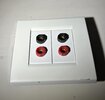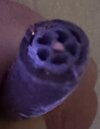- Joined
- 5 Jan 2024
- Messages
- 1
- Reaction score
- 0
- Country

Moved into a new flat where there are two expensive ceiling speakers fitted. Exciting! However, plugged my amp into the speaker socket and couldn’t get any output.
Having opened the socket, there is a cable in there not connected to anything. Nothing is connected to the face plate. It doesn’t look like speaker cable to me… is it coax?
There is no obvious other cabling point in the house. I am fearing the speakers either cabled in, or have been plastered over. Any ideas how I can track them?
Having opened the socket, there is a cable in there not connected to anything. Nothing is connected to the face plate. It doesn’t look like speaker cable to me… is it coax?
There is no obvious other cabling point in the house. I am fearing the speakers either cabled in, or have been plastered over. Any ideas how I can track them?



